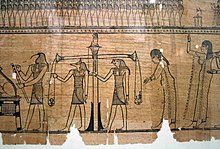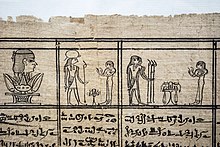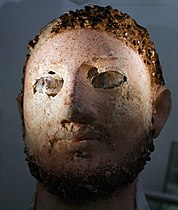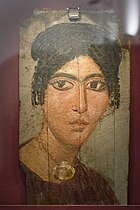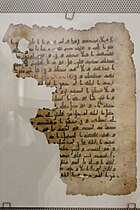
Papyrus is a material similar to thick paper that was used in ancient times as a writing surface. It was made from the pith of the papyrus plant, Cyperus papyrus, a wetland sedge. Papyrus can also refer to a document written on sheets of such material, joined side by side and rolled up into a scroll, an early form of a book.

Papyrology is the study of manuscripts of ancient literature, correspondence, legal archives, etc., preserved on portable media from antiquity, the most common form of which is papyrus, the principal writing material in the ancient civilizations of Egypt, Greece, and Rome. Papyrology includes both the translation and interpretation of ancient documents in a variety of languages as well as the care and conservation of rare papyrus originals.
The Fayyum Fragment is a papyrus fragment containing text that could be from part of the New Testament, and consists of only about 100 Greek letters. The fragment was originally discovered in Al-Fayyum, Egypt, and was translated in 1885 by Gustav Bickell after it was found in the papyrus collection of Archduke Rainer Joseph of Austria in Vienna.

The Austrian National Library is the largest library in Austria, with more than 12 million items in its various collections. The library is located in the Neue Burg Wing of the Hofburg in center of Vienna. Since 2005, some of the collections have been relocated within the Baroque structure of the Palais Mollard-Clary. Founded by the Habsburgs, the library was originally called the Imperial Court Library ; the change to the current name occurred in 1920, following the end of the Habsburg Monarchy and the proclamation of the Austrian Republic. The library complex includes four museums, as well as multiple special collections and archives.

Archduke Rainer Ferdinand Maria Johann Evangelist Franz Ignaz of Austria was an Austrian prince and politician who served as Minister-President of Austria from 1861 to 1865. Later in his life, he took up the collection of preserved papyri, largely from Egypt, and served as a benefactor and patron while working with the Oriental studies department of the University of Vienna. His purchases of papyri from Egypt formed the Rainer collection at the Austrian National Library.
Papyrus 55, signed by 𝔓55, is a copy of the New Testament in Greek. It is a papyrus manuscript of the Gospel of John. The surviving texts of John are verses 1:31-33, 35–38.
Papyrus 56, signed by 𝔓56, is an early copy of the New Testament in Greek. It is a papyrus manuscript of the Acts of the Apostles, it contains only Acts 1:1.4-5.7.10-11.
Papyrus 57, designated by siglum 𝔓57, is an early copy of the New Testament in Greek. It is a papyrus manuscript of the Acts of the Apostles, it contains only Acts 4:36-5:2.8-10.
Papyrus 76, signed by 𝔓76, is a copy of the New Testament in Greek. It is a papyrus manuscript of the Gospel of John. The surviving texts of John are verses 4:9,12.

Uncial 0177, is a Greek-Coptic uncial manuscript of the New Testament, dated paleographically to the 10th-century.

Uncial 0181, is a Greek uncial manuscript of the New Testament, dated paleographically to the 4th-century.
Uncial 0182, is a Greek uncial manuscript of the New Testament, dated paleographically to the 5th century.

Uncial 0183, is a Greek uncial manuscript of the New Testament, dated palaeographically to the 7th century.

Uncial 0184, is a Greek-Coptic diglot uncial manuscript of the New Testament, dated paleographically to the 6th century.
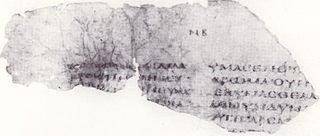
Uncial 0185, is a Greek uncial manuscript of the New Testament, dated palaeographically to the 4th-century.

Uncial 0186, is a Greek uncial manuscript of the New Testament, dated paleographically to the 5th-century.

Uncial 0213 is a Greek uncial manuscript of the New Testament, dated palaeographically to the 5th or 6th century.

Katolophyromai, is the headword in a musical fragment from the first stasimon of Orestes by Euripides. It means "I cry, lament so much." In 1892, among a number of papyri from Hermopolis, Egypt, in the collection of Archduke Rainer Ferdinand of Austria, a fragment was discovered and published by the papyrologist Karl Wessely, containing a mutilated passage with musical notation. Although Vienna Papyrus G 2315 dates to the third century B.C., the melody recorded on it may have been written much earlier.

Karl Wessely was an Austrian palaeographer and papyrus scholar. He examined manuscripts housed at the Austrian National Library and in other important European libraries.
Gertrud Maria Elisa Thausing was an Austrian Egyptologist, and the head of the Institute for Egyptology and African Studies at the University of Vienna from 1954 to 1977.


